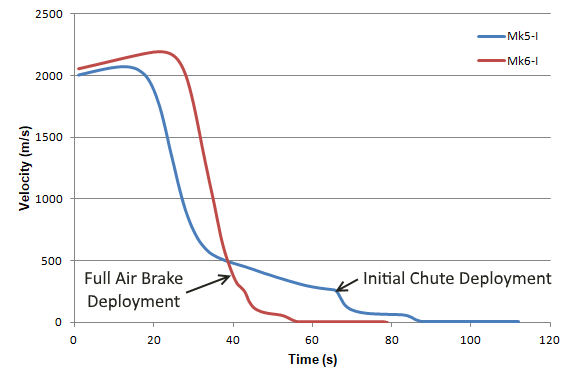 Prevented from launching for over two months due to legal and political wrangling the second flight of the Progeny Mk6 was finally able to head up into space and also successfully made it back to the surface intact for recovery thanks to some new tech that reached maturity during the delay. This was the third launch in a series of flights designed to probe out the region of hazardous radiation originally detected above the planet by earlier Progeny Mk5 flights. We have theories on what might be up there, but only hard data will tell us what actually exists. Thanks to the success of this flight we are a step closer to knowing, with two more planned to hopefully complete our initial understanding.
Prevented from launching for over two months due to legal and political wrangling the second flight of the Progeny Mk6 was finally able to head up into space and also successfully made it back to the surface intact for recovery thanks to some new tech that reached maturity during the delay. This was the third launch in a series of flights designed to probe out the region of hazardous radiation originally detected above the planet by earlier Progeny Mk5 flights. We have theories on what might be up there, but only hard data will tell us what actually exists. Thanks to the success of this flight we are a step closer to knowing, with two more planned to hopefully complete our initial understanding.
The Flight
Despite the long break between launches regular drills kept everyone ready to resume operations and no troubles arose during the operations leading up to the launch, which occurred on schedule after high surface winds earlier in the day died down to acceptable levels. The Automated Flight Control System fired off the first stage 0.625m booster at precisely 13:58:00.05 local time, which pushed the rocket off the launch base with an initial thrust of 67.2kN for 4Gs of acceleration on a heading of 120°. This force was enough to keep drag at the nose from pitching up the rocket any more than 1.5° before the fins began to spin up and stabilize the remainder of the flight. The lower booster’s thrust peaked at 68.9kN just 3.6 seconds into the flight before the solid fuel core design began a thrust reduction to keep the vehicle’s speed under control as it passed through MaxQ at L+17.9 seconds traveling at 504.53m/s with a dynamic pressure of 77.987kPa. The first stage burned out after 33.67 seconds of powered flight and separated cleanly one second later. A second after that the fins were shredded with explosives to spoil the booster’s aerodynamics and send it plummeting towards the Kerblantic, where it impacted 19km downrange at L+3m9s.
After stage separation the rocket coasted for 7.5 seconds before the nose dropped 1.5° and triggered the ignition of the second stage solid rocket booster, which occurred at 19.012km with an initial thrust of 14.7kN for an acceleration of 2.9Gs (the booster is set to produce 3Gs at 20km). Still flying stable, the rocket accelerated to 867.62m/s by the time the booster ran out of fuel 13.18s later at an altitude of 27.878km. Stage separation was clean and occurred in the same manner as the first stage, with the booster falling back to the water for splashdown 46km downrange at L+4m38s.
The third stage was lit off at full throttle one second after stage separation, producing nearly 12kN of thrust and pushing the rocket’s apokee out of the atmosphere as it continued to climb under power for the next 30.78 seconds, ending just 4 milliseconds after crossing over the 70km ASL boundary into space at a speed of 2.113km/s – setting a new record for atmospheric velocity by a rocket.
Over the next 9 minutes the rocket coasted up to an apokee of 515.953km, which was lower than the previous two flights but still high enough to reach the hazardous radiation region. After passing through its highest point at L+10m33s the downward journey began as controllers kept an eye on battery levels and scientists an eye on radiation levels. The rocket breached the atmosphere at L+19m38s traveling at 2.114km/s. Already 277.8km downrange the rocket fell below the horizon a few seconds later and comms were lost even before re-entry heat cutoff the signal. It was now up to the newly-installed air brakes to help ensure a successful recovery.
This time we had a recovery ship positioned nearby to gather transmitted telemetry data as the rocket made its final descent through the atmosphere, but thankfully the recovery of the payload allowed us to access the more detailed onboard telemetry. Once it passed through the worst of re-entry heat and forces at 6km the fairing pieces were detached to expose the payload trusses and help induce some extra drag. At this time the three air brakes were partially deployed to prevent aerodynamic forces from collapsing them back into the fuel tank, which would have likely ruptured and possibly exploded if any vapors remained in the tanks. By 2km the air brakes were fully deployed and the parachute was pulled out from the nose cone at 1.8km while the rocket was traveling at 320m/s, within the normal limits of the chute tolerance. The payload splashed down intact traveling 7.5m/s at L+20m55s 299.8km downrange.
Flight Analysis
Launching further south, the rocket’s ascent was likely further influenced by the rotation of Kerbin traveling more lateral to its flight, but we won’t be able to really analyze this until the remaining two flights are completed and we can look at all the data together. The rocket’s coast phase was shorter and the apokee was far shorter than the record-setting previous flight up to 580.571km but again we can’t really identify exactly why this is without more data from future flights – it could be from launching further south or it could be from the weight and drag added by the air brakes (this rocket did set a new record for heaviest launch weight, minus payload, at 1.710t). Overall though the flight was nominal.
The radiation data collected was especially intriguing as after the rocket began to see an increased level of radiation passing through 360km the levels began to fall back off and returned to normal before the rocket reached apokee. They did not increase again as the rocket fell back to Kerbin so this is the first time we passed completely through the radiation region and completely out of it as well. The rocket continues to encounter the initial increase of radiation levels at higher and higher altitudes, a sign that means the field may be curving away from the planet as we fly further south. Once again, more data is needed from these next to flights to paint the full picture.
The air brakes may have performed admirably on this flight, but everyone still has reservations as to whether they can successfully return a rocket from beyond 500km apokee reliably every time. We’re not entirely sure how much force would be needed to cause them to fail, as it’s not just them we need to consider but the rigidity of the fuel tank as well. It’s likely the air brakes could withstand much higher forces okay but having those forces also applied to the tank could cause it to crush. We may need to explore options of pressurizing the tanks to increase the chances of recovery from higher altitudes. Worry of that aside, it is clear they did play a major role in the safe recovery of the rocket, as shown by this graph:
 The closest flight to this one was the second Mk5 Block I that reached an apokee of only 493km and returned intact without air brakes. You can clearly see where its loss of speed drops as it enters the thicker lower atmosphere but begins to glide thanks to body lift. The Mk6 however sees a continued rapid decrease in speed thanks to the successful deployment of its air brakes.
The closest flight to this one was the second Mk5 Block I that reached an apokee of only 493km and returned intact without air brakes. You can clearly see where its loss of speed drops as it enters the thicker lower atmosphere but begins to glide thanks to body lift. The Mk6 however sees a continued rapid decrease in speed thanks to the successful deployment of its air brakes.
Future Plans
The next launch is already coming up fast tomorrow, set for 18:18 UTC. We do not plan to make any changes at all to the rocket, the ascent profile or the command code. The only change will be to launch yet further south along an azimuth of 135°.







